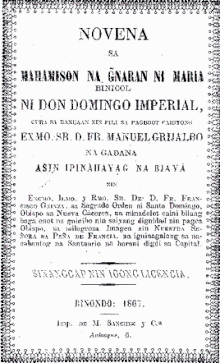Novena
A novena (from Latin: novem, "nine") is an ancient tradition of devotional praying in Christianity, consisting of private or public prayers repeated for nine successive days or weeks.
[5] The practice of novena grew by the Middle Ages to include pious prayers for nine days before a feast in honor of a saint identified on a liturgical calendar.
By the 11th century, the novena practice had become a means in Christianity of praying to petition spiritual or personal favor through a saint, such as the Virgin Mary.
[7]Within the Roman Catholic tradition, novena prayers typically include a praise of Jesus Christ, the Virgin Mary or another saint, and a personal petition.
[9] A novena is a ritualistic devotional worship where one or more Christian devotees make petitions, implore favors, or obtain graces by honoring Jesus Christ, Virgin Mary or the saints of the faith who are believed to empower divine intervention.
Various denominations of Christianity in Africa have introduced regional novena practices that include devotional prayers, singing, and clap, wave, or shout offerings.
The novena devotionalism in Ghana includes on each of the nine nights, after the loud prayers, the blood-covering of Jesus, where the devotees stain themselves considering it to be symbolism for the blood of Christ.
[24] In Zimbabwe, according to Lawrence Daka – a professor and a Zimbabwean Jesuit: Their [Catholic clergy] healing sessions are theatric, hysterical, loud and really engaging to the extent that some people fall to the ground and others feel the power of God piercing through their bodies.
In short, there is a great yearning and thirsting for a religion that delivers quick answers to people’s problems which range from misfortunes to dealing with illness and death.
The novena had strong roots in ethnic neighborhoods, and devotional worship had sociopolitical links, offering a sense of communal security through religious symbols in a period of uncertainty and fear.
[26] As economic prosperity and a sense of national solidarity grew in and after the 1960s, the novena ritualism waned and the participation in church worship services fell.
[32] The Novena-Seance remain popular in many regions of the United States, such as among the Roman Catholics of Louisiana, where novenas are dedicated to St. Jude and the Virgin Mary.
[34][35][36] According to Patrick Taylor and Frederick Case, attendance at Christian religious services has been low, except after the death of a loved one or a significant socio-political individual, and during times of difficulty such as epidemics or a drought.
[37][38] Many perform devotional worship with rosaries within their home before images of Christ and the Christian saints at a small dedicated altar within their living spaces.
[38] Like proselytism in Africa and Asia, missionaries of various denominations of Christianity, including Protestantism, have championed novenas in Hispanic-Latino communities as a part of their efforts to attract new converts to their ministries.
In Christian communities of the Philippines and Latin America, novena traditions include devotional rituals in front of an altar, with nine levels where the Holy Cross is placed at the top.
[46] During the main procession in Cebu City, the Santo Niño image is taken through the streets, with many people carrying their own replicas, decorated according to their own tastes.
[46] In Loboc, Bohol, the most popular novena is dedicated to a Black Madonna statue, with each service called the Gozos, which includes a chanting of praises to the Virgin in Spanish and Visayan, dancing, choir recitals, and a feast with fireworks on the last day.
[47] In Metro Manila, popular novenas to Our Lady of Perpetual Help, Saint Jude Thaddeus, and the Black Nazarene are assigned to the last three days of the working week.




